This article may contain affiliate/compensated links. For full information, please see our disclaimer here.
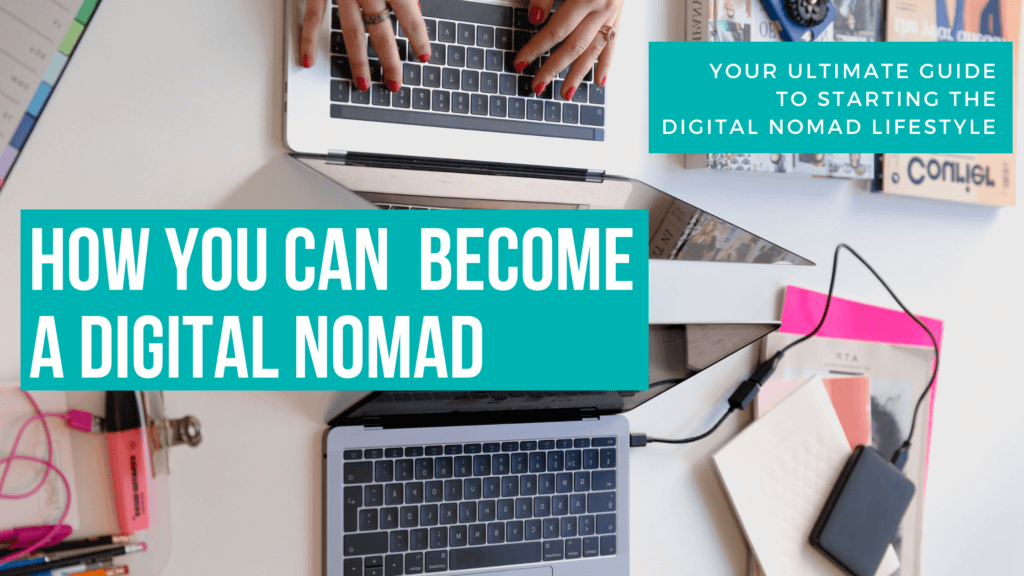
Do you want to start traveling the world and are wondering how to become a digital nomad? It sounds and looks appealing, right? Laying in a hammock at the beach, a cocktail in hand, laptop buzzing in your lap, money rolling in.
Are you ready to become a digital nomad? Download our Digital Nomad Checklist
We hate to break it to you, but this picture of digital nomad life is VERY unrealistic.
For one thing laptop + sand = disaster. Not to mention the glare from looking at a screen outdoors.
Plus, it’s pretty hard to both work and relax at the same time, amirite?
We don’t mean to burst anyone’s bubble. We just want to make it clear that being a digital nomad doesn’t mean you’re on one big long vacation like social media might have you believe.
The truth is, the images the term “digital nomad” conjures aren’t the reality of what life looks like for most people doing it, and we want you to know that upfront.
We’re not saying this lifestyle isn’t amazing!
But it’s important to think about the balance you want to strike with your work-travel lifestyle before you dive headfirst into becoming a digital nomad.
What is a Digital Nomad?
The idea of being a digital nomad is to make money from your laptop or phone while you’re traveling so you can pay your bills and sustain your life on the road (and ideally save and invest for your future along the way).
But there is a big difference between traveling or being on vacation and being a digital nomad who relies on working to maintain their lifestyle, however fancy or simple that lifestyle might be.
We also want to say that our nomadic lifestyle isn’t better or more special than anyone else’s life. Travel can be a form of temporary escape, sure. But uprooting your current life to move abroad isn’t going to fix all of your problems.
However, if long-term travel is a big dream on your heart and you think you might love living in different places around the world, and all of the challenges, unknowns, excitement, and freedom that come along with that, then we’re here to tell you that your dreams are possible.
We’ve been both full-time travelers and digital nomads at different points and can tell you that these are very different things. One isn’t better than the other (okay that’s a lie, just traveling is obviously more fun).
Like learning through videos? Check out our Digital Nomad Lifestyle Youtube playlist.

Traveling and Vacations VS. the Digital Nomad Lifestyle
During the periods of our life when we were just traveling, we were in a cycle that is familiar to a lot of people: work-save-travel-repeat.
We would work hard at our jobs and save save save. Then we’d stop working and travel for weeks or months at a time. Funds ran low, then it was back to work. Save save save. Stop working. Travel. You get the idea.
We did this cycle for over six years while working at schools in China and Cambodia.
It worked well for us, especially because we had long holidays and summer breaks when we could travel for several months out of the year.
We even traveled for six months between jobs at one point. But there came a time when we didn’t want the travel part of the cycle to stop, and we were tired of being at the mercy of our work schedules. We wanted more freedom.
Our Foray into Digital Nomad Life
In the summer of 2018, we decided to leave our jobs and start digital nomad life.
Looking back, we had a pretty unrealistic idea of what it would be like. When we started, we attempted to travel the way we had before and also fit in work when we could. We were running our travel blog and doing some freelance writing and editing as well.
We had it in our minds that digital nomad life would feel like one long vacation, and we were basically living that way while simultaneously not getting enough work done to maintain our bank balances.
Several months in it felt like neither work or travel was going particularly well. IT. WAS. STRESSFUL. And we had put all this stress upon ourselves.
When I tell you we’ve made all of the mistakes mentioned above, I mean it (getting sand in our expensive electronics included). And I know we’re not alone.

Types of Digital Nomad Jobs and How Much $ They Make
First of all, “Digital Nomad” isn’t a job. It’s a term for people who work remotely from their laptops while moving around from place to place. The money side depends on the work that the digital nomad is doing. None of it happens without hard work!
Jobs for digital nomads can be all kinds of things. We know digital nomads who are bloggers, web designers, who work for companies, are virtual assistants, teachers, accountants, marketing experts, YouTubers, podcasters, the list goes on. Many digital nomads, like us, have multiple streams of income.
You can check out these websites for finding remote jobs or marketing your services:
–WeWorkRemotely.com
–FlexJobs.com
–Remotive.com
–Indeed.com
–Fiverr.com
–Upwork.com
In reality, there are digital nomads out here making different amounts of money, living all types of different lifestyles.
Some digital nomads can afford to stay in fancy high-rise penthouses in major cities, while others may choose to live in local village homestays. Some may stay in co-living spaces or hostels, while others might reduce their accommodation costs through house sitting.
The pace of travel differs as well. Some digital nomads move to different places every few days, while others stay in one place for several months at a time. Some, like us, do a mixture of both.
It all comes down to the type of work that you do and the kind of lifestyle you want to live. The options are endless, and it’s entirely up to you.
Just be prepared that sometimes the digital nomad lifestyle might require you to work more than you would in a 9-5 job, especially if you run your own business. In our opinion, the hard work is worth it for the freedom we now have!
Finding a Healthy Balance FOR YOU
Seven years into the digital nomad lifestyle, we’re happy to report that we’ve got a much better handle on our work-travel balance. And of course, we’re always getting better!
We’ve learned A LOT through our experiences, and from the countless other travelers and digital nomads we’ve met along the way.
We wouldn’t be where we are today without the influence and examples of other people we’ve met living this lifestyle, which is why we want to pass this info on to you.
In this article, we’ll do our best to prepare you for what digital nomad life can ACTUALLY be like when you plan ahead and know what to expect.
We’ll do our best to help you avoid the mistakes we’ve made AND help you figure out what an ideal travel-work lifestyle looks like for YOU.
So grab a tasty beverage and strap in! This is a long read, but we promise it will be worth it.
You’ll probably want to Bookmark or Pin this article to come back to later too!
It’s All About YOU
It’s time to get a little selfish here. This is YOUR life after all.
The first thing we want you to do is to answer a few questions for yourself.
Carve out 10 minutes to sit down and think about your answers to these questions and what you “ideally” want. You can even write out your answers or say them into a voice note- whatever is a good way for you to process them.
If you’re planning to travel with your partner, go through these questions individually and then together to see where you both stand and then have a conversation.
Questions to Ask Yourself
- Why is the long-term travel lifestyle appealing to me?
- What types of activities am I looking forward to doing (more of) while traveling?
- What is my ideal work-travel balance?
- What’s my ideal travel pace? (spending days/weeks/months in each place)
I also want to remind you as you go through this that there are no right answers, and you’re free to change your mind and change your direction as many times as you need and want to. This is just to get some ideas flowing.
The Dreaming Stage
Obviously, the reason you want to start this lifestyle is to travel, and likely to have more freedom. So let’s play a bit more here.
Based on your previous answers about the activities you want to do more of and your ideal work-travel balance, let’s consider which places in the world are a good fit for your desired lifestyle.
Where do you want to go?
List at least three places (cities or countries) that you’re most excited to go to.
1._____________________
2._____________________
3._____________________
How long do you want to spend in each place?
What have you heard about these places that makes them so appealing to you?
Take it a step further: Join at least one group on Facebook for a place you want to go. You can search: “Travel in X Place” or “Expats in X place” and then request to join that group. Inside these Facebook groups, people discuss what daily life is like there, the cost of transportation, food, and accommodation. Some groups require you to answer questions to join, so you can let them know you’re thinking of traveling there soon and that’s usually enough to be allowed in. See an example here.
One thing that makes the digital nomad lifestyle sustainable is staying in places for longer. We tend to stay in one city for 1-3 months at a time. Then we use it as our base to explore that region.
We’ve learned that this works out well for three reasons:
- We can settle into a routine of getting work done and exploring.
- We get to know a city/region better.
- It’s more cost-effective.
It’s cheaper because we can get better deals on accommodation, get to know local restaurants, and find good markets so we can cook meals at home. We can learn to use the local transportation systems, and get the experience of living (more like) a local rather than paying inflated tourist prices.
Logistics of the Digital Nomad Lifestyle
Digital Nomads have some specific needs that differ from travelers, especially since they often travel to countries and stay longer.
Some important things to consider are:
- How long am I legally allowed to stay in the countries I want to go to?
- Do the countries I want to travel to require me to get a visa ahead of time?
- Should I get a Digital Nomad Visa? (you might not need to!)
- What are the current entry requirements of those countries? (Vaccine requirements, Covid-19 testing, etc.)
- Does my passport have at least one year of validity left on it?
A lot of this comes down to your passport country. If you’re an American, there are over 140 countries you can travel to visa-free. This means you can enter the country without needing to obtain a visa ahead of time.
Even more incredibly, many of these countries allow Americans to stay for 30 to 180 days at a time.
If you do need to get a visa, it’s usually pretty easy to apply online. The company iVisa has updated information about visa requirements for different nationalities. We’ve used their services to get visas for traveling to India and it was quick and easy.
The best places to research how long you can stay in a country and the entry requirements are through your country’s government website and the government website of the country you are planning to visit.
For Americans, you can check this information on Travel.State.Gov.
Many digital nomads stay for the length of time they are allowed in a country, either visa-free or with a tourist visa, then move on.
However, some countries are now offering Digital Nomad Visas, which allow remote workers to stay for longer periods of time or even obtain residency.
Now that you’ve got an idea of where you want to travel to and for how long, it’s time to get some more important pieces in place.
Travel Health Insurance
Getting travel insurance is basically a non-negotiable. Not only will most countries require you to have it, but you’ll definitely want it if you need it.
We currently use SafetyWing which is travel insurance designed for remote workers and digital nomads.
Genki is another insurance company for nomads and long-term travelers.
We’ve also used World Nomads insurance over the years, which is a great option if you’re a more adventurous traveler and like to partake in riskier activities.
We wrote these articles comparing: World Nomads vs. SafetyWing and SafetyWing vs. Genki with info about all three companies and what they cover.
We also made this video about World Nomads and SafetyWing where we share about about health insurance and our experiences using it abroad and this video compares what you get with SafetyWing and Genki.
It’s important to note that travel insurance is coverage for unforeseen medical issues, accidents, and illness that occur while you travel. It won’t cover pre-existing conditions and routine health or dental care.
However, both SafetyWing and Genki now have more comprehensive health plans:
Get a Genki Resident Quote
Get a SafetyWing Nomad Health Quote
Our Experience Using Insurance Abroad
Personally, we’ve been comfortable paying for preventative and routine treatments that travel insurance doesn’t cover out of pocket while we’re abroad (usually in Thailand, Malaysia, and Albania) because it is affordable.
As I mentioned, we spent six years working in education in China and Cambodia. When we were in China we had more comprehensive health insurance through our jobs to cover us for routine healthcare.
When we were in Cambodia, our jobs gave us stipends to use toward healthcare. At that time we purchased insurance from a local broker with an insurance company called LUMA which covered us for travel around Asia. Whenever we traveled during holidays and breaks from work we purchased World Nomads insurance to cover us.
When we started digital nomad life in August 2018 we kept our LUMA insurance.
In early 2019, I found out had a tumor on my ovary and needed to have surgery to remove it. I had the surgery done at one of Bangkok’s top hospitals called Samitiveg Sukhumvit.
The operation would have cost over 6,000 USD out of pocket but it was completely covered by my LUMA insurance, except for a few outpatient doctor visits which cost about 500 USD out of pocket in total.
In 2021 we switched to SafetyWing Nomad Insurance. We’ve been happy with this coverage, though thankfully we haven’t needed to use it yet.
Of course, everyone’s medical needs will differ so please be sure and do your research so you are comfortable with the health coverage you have.
Check out these Resources for Travelers and Digital Nomads

Get our FREE Digital Nomad Checklist to see what you have already done, and what you still need to do to start DN life.
Finances for Digital Nomads
Cost of Living
You’ll want to get a sense of the cost of living in the places you want to travel to.
Of course, cost of living can vary wildly based on your personal preferences, your budget, and how you like to spend your money. Check out our article on the cost of living in Phnom Penh, Cambodia to see what we mean.
There are plenty of places you can live around the world for $1,000 per person or even less!
As we mentioned before, you can find a lot of information about the cost of living in a place through Facebook groups and from people who are currently in those places.
Reading blog articles from people currently living in that place is another excellent way to research. Search “Cost to live in X place digital nomad” on Google, Pinterest, and YouTube and do some research.
You can also check out websites like Nomad List which does cost breakdowns for cities around the world.
Remember to take into account things like the high and low seasons in the places you want to go. For example, we’re currently in Saranda, Albania in February. This city is a hot summer destination, but right now it’s pretty quiet (despite the weather being absolutely beautiful-lucky us!). This means rents are significantly lower right now than they would be in high season, which has been a great way to reduce our overall living costs. And we have the added benefit of it being less crowded, which we like.
Emergency Fund
We highly suggest that before you head off for your travels that you have an emergency fund built up with at least three months of living expenses. This is money you hopefully won’t need to touch, but it’s there in case you lose your job or have unexpected expenses like needing to fly home for an emergency.
Ideally, you’ll be able to build up your emergency fund even more over time to have six months or even a year of savings in it.
A Plan to Pay Off Bills and Debt
Some people may not agree with this (we’re looking at you, Dave Ramsey), but you CAN live your life and even travel the world if you have debt.
In fact, in our experience, it’s easier to pay off credit card and student loan debt while living and working abroad simply because we’ve been able to spend less and save more than we could while living in the US.
We completely paid off our credit card debt in less than a year after moving abroad in 2011 and have paid off our credit cards in full every month since then.
We’ve still been paying off student loan debt every month, which is the same thing we’d be doing if we were living in the US.
Watch: Why We Won’t Move Back. How we view the US after 12 years abroad
The most important things here are to have a plan in place to continue paying off your debt while you travel and not to miss any payments.
This isn’t an article strictly about finances, so we won’t go into details here, but basically, you need to make paying down debt a priority and factor it into your budget the way you would with other monthly expenses like accommodation so that you are consistently paying it down.
Taxes
We aren’t accountants and we can’t advise you on your specific situation.
What will we say is that you need to put a plan in place for paying off your taxes on time. If you work for a company, make sure you speak to HR about your tax situation. If you’re self-employed and need to pay quarterly taxes, make sure you factor that in.
You may even want to work with a tax professional who specifically knows the ins and outs of taxes for digital nomads.
Wee! Isn’t adulting fun!
Let’s move on to more exciting topics…
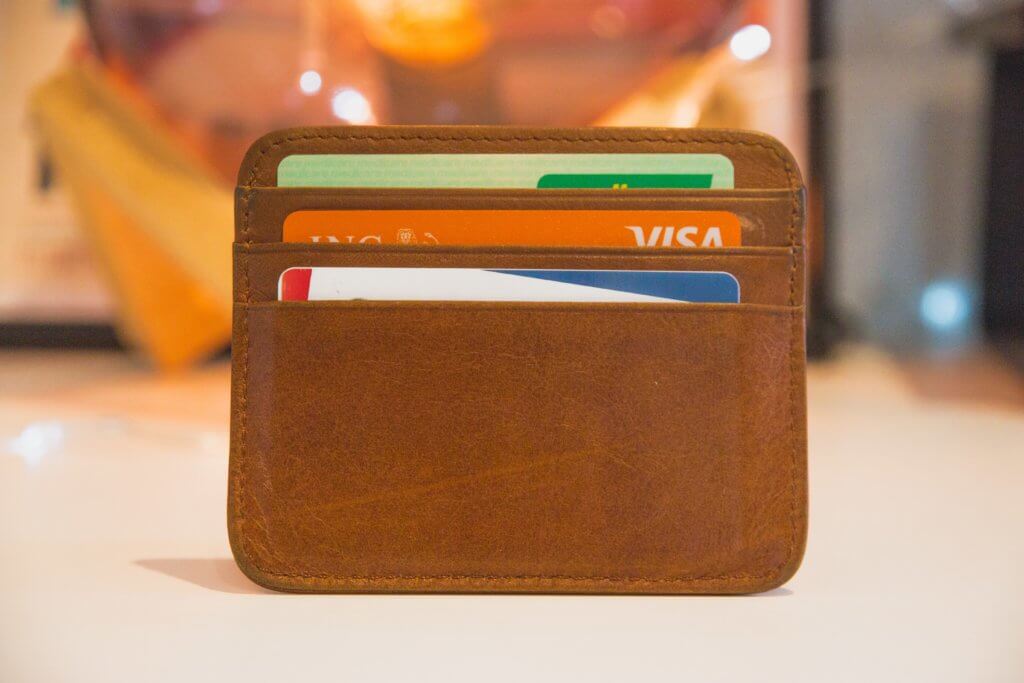
Banking and Credit Cards!
I’m sorry, I wasn’t trying to trick you. This part actually is really interesting and useful if you like free flights and hotels and saving money.
Three things to think about with this topic:
#1 Get a Credit Card with NO International fees. There are so many good options for this.
Some credit cards charge a 1-3% transaction fee when you use them abroad, which may not sound like much, but that really starts to add up!
Luckily, there are plenty of credit cards that have no international transaction fees that you can get. We use Chase, Citi Bank, and Capital One credit cards.
On top of having no foreign transaction fees, many credit cards have amazing intro offers where you can get a large number of points/miles that you can use toward free flights and hotels.
Some of those credit cards do have annual fees, so you’ll have to decide which ones are worthwhile for you based on the perks they offer. We get into that more in detail in this article.
You can check out Nerd Wallet and The Points Guy for more credit card reviews and options.
#2 Get a Debit Card with NO ATM fees.
This tip alone is going to save you hundreds of dollars! In a majority of countries around the world, you’re going to need to pay in cash for your daily needs like groceries, restaurants, pharmacies, activities, etc.
This means you’ll need to withdraw money from ATMs. Unfortunately, most ATMs have fees of $5-8 USD every time you make a withdrawal. So you’re stuck either pulling out a large amount of money to avoid incurring more fees, (and then stressing about carrying around a bunch of cash!), or you withdraw money more frequently but end up paying a ton in fees every month, which is just silly because YOU DON’T HAVE TO.
The best debit card we know of is Charles Schwab.
That’s because you can use your Charles Schwab debit card at millions of ATMs in over 200 countries and territories around the world. The best part, any ATM fees you pay while using your Charles Schwab debit card are returned to your account every month.
Another bonus is that you incur no foreign-exchange transaction fees for purchases made with your card.
We’ve been using Charles Schwab for over 10 years and it has saved us hundreds, if not thousands of dollars at this point.
#3 Notify Your Bank and Credit Card Companies About Your Travels
The last thing you want is to be halfway across the world and have your cards frozen by your bank or credit card company for “suspicious activity” when you’re just trying to pay for dinner on your first night out in a new country.
Not being able to withdraw money or use your cards would be a HUGE pain in the butt, so let your bank and credit card companies know where you’re going before you leave your home country.
We also put a spending limit on our cards, so our credit card company won’t flag purchases unless they’re over a certain limit. This is helpful so we don’t have to notify them every time we travel somewhere new. But if you do this then you’ll want to employ tip #4…
#4 Monthly Finance Check-ins
I know I said three things, but we’re overdelivering on the useful info here for you, and this one is muy importante.
We do a monthly finance check-in, usually around the end of each month or the beginning of a new month, just to make sure there aren’t any suspicious transactions or activities happening with our accounts.
We advise you to do the same. It’s also a good chance to check in on your spending habits.
You’ll want to remember to turn on your VPN whenever you’re doing these finance checks to make sure your information is protected, which leads us to our next section…
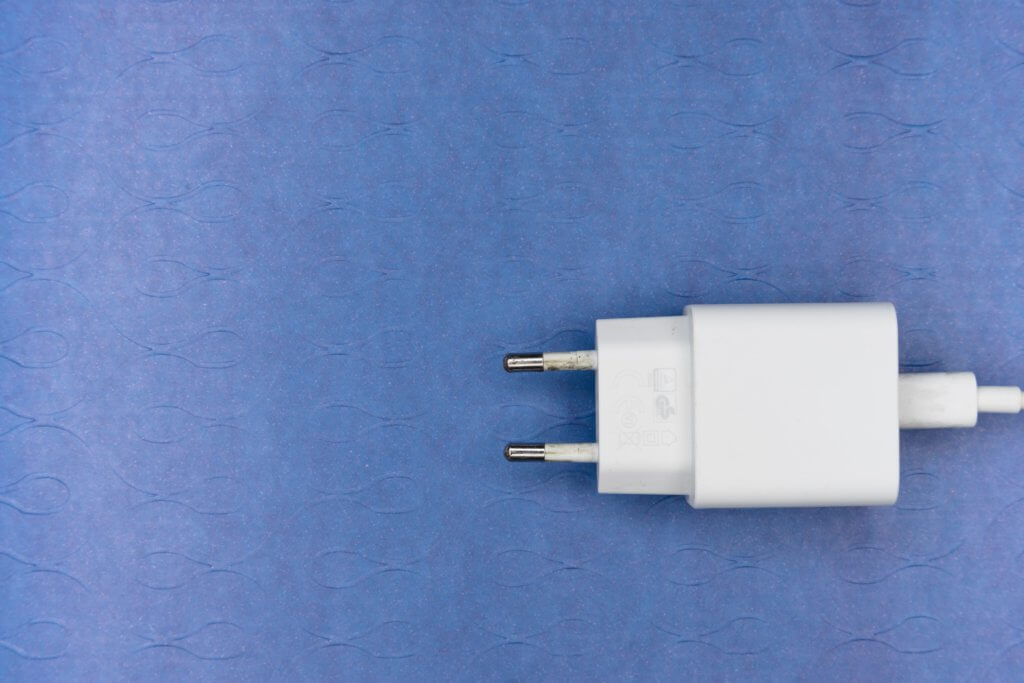
Technology
We have three important suggestions for you in this section. Yes, it is actually three this time.
#1 Get a VPN.
Having a VPN is vital when you’re traveling because you’ll be connected to Wifi in lots of different places.
A VPN protects you from other users stealing your data, like usernames, passwords, credit card numbers, browser cookies, and other identifying information.
It also allows you to access the internet as if you are in your home country or any other country you want to appear to be in, which comes in handy if you are trying to watch certain shows on Netflix.
We have used Nord VPN for many years now and would definitely recommend them.
#2 Get a Universal Power Adapter
Different countries have different plugs, so you’ll want to get one of these babies to make sure you can plug in your devices and stay charged.
Thankfully, a Universal Power Adapter is super affordable. You can get one like this for as little as $10 on Amazon.
If you’re traveling with a partner, get a Universal Power Adapter for each of you. You shouldn’t need more than this because once you are in your destination, you’ll be able to pick up local power adapters with an exact voltage match for even cheaper (usually $1-3 USD).
Power outlets around the world run in two voltage ranges: 110-127V or 220-240V.
If your device falls within either range or variations within that range, it shouldn’t be a problem for short-term use. So for example, if the local power is 110V and your device lists its input at 120V, it will still work because it’s within the 110V-127V range.
However, if the local power is 220V and you plug in your expensive hairdryer with an input of 110V, then it will, quite literally, explode. I’m sadly speaking from experience here. I’ve also exploded a very nice blender this way.
You can check the voltage in the countries you are traveling to here.
You can also check the voltage requirements for your devices on the device itself, or sometimes on the plug or the power cord in teeny-tiny print. (Zoom in on the picture above to see an example.)
These days many devices like laptops and phone chargers will say “Input: 110-240V” which means it has dual-voltage capabilities and you won’t need a voltage converter. But you should still check!
We have a “bag of tricks” as we like to call it, which is full of different plug adapters from different countries which have really come in handy.
#3 Cloud Storage
Having cloud storage is useful to store your important documents like copies of your passport, vaccine records, and anything else you may want to have easy access to.
Cloud storage is especially handy if you’re like us and you take a bazillion pictures and videos everywhere you go.
We have both iCloud and Google Drive cloud storage and we upload files to them regularly to clear space on our phones.

Accommodation
Back to some fun planning!
What types of accommodation would you like to live in while you’re traveling?
Of course, this depends a lot on the type of work you do and the kind of lifestyle you prefer.
Ask yourself: What are my “must-haves” when it comes to accommodation? (fast/reliable wifi, a kitchen with appliances, central location, etc.) before you begin your search.
Apartments
If you prefer to have your own space and want to work from home, then an apartment or home is usually your best bet.
In this case, Airbnb or expat Facebook groups are a great way to find apartments.
As online teachers, we need two separate spaces to teach from where we can’t hear each other, so we prefer to stay in apartments or homes with at least one or two bedrooms.
We also love to cook, so we prefer to have a good kitchen with appliances included when possible.
You can use the filters on Airbnb to find places that have what you’re looking for.
Check out the apartment we rented for one month in Saranda, Albania!
Hostels & Co-Living
If you’re traveling solo and can do your work from anywhere, then you might be okay with staying in hostel dorms and doing your work in co-working spaces or at cafes. Hostels are a great way to meet people.
When Stevo and I travel separately and aren’t teaching, this is what we usually do.
There are also options for co-living where you share a larger home or apartment with multiple people who also work online, which is a great option if you thrive being around people.
Housesitting
One of our favorite ways to find housing is through Trusted Housesitters. This website connects you with people around the world who have pets, plants, or properties that need to be looked after while they are away.
Housesitting works as an exchange, so you stay in the homeowner’s home and take care of their pets and anything else they need and you get to live in their home rent-free, often with very fun and sweet pets! Learn more about housesitting.
Trusted Housesitters has a huge worldwide database of homeowners. We’ve done house sits in the US, France, Hong Kong, the UK, Thailand, Malaysia, Romania, Peru, Costa Rica, Panama, and plan to do many more in the future!
There’s nothing to say you can’t try all of these types of accommodation out at different points to see what suits you. We’ve shared our six favorite ways to find digital nomad housing in this article.
Transportation
One of the biggest money-saving things you’ll do when you leave the US is getting rid of your car and all of the expenses that come along with it (gas, insurance, monthly payments, maintenance, etc.).
Around the world, most places have reliable, inexpensive public transportation. You’ll be able to get around on buses, trains, trams, taxis, tuk-tuks, rickshaws, local ride-sharing apps, bicycles, scooters, the list goes on. Figuring out how to use public transportation is one of our favorite parts about being in a new place because it’s always a slightly different experience.
These days there are local apps similar to Uber in many countries around the world. We’ve written about these and other apps that are very helpful when traveling in Asia and Europe.
You may also want the option to rent a car or a motorbike while you travel. In this case, some countries might accept your home country’s driver’s license, but others require an international driver’s license.
As Americans, we were able to get International Driver’s Licenses through AAA very quickly and easily, even though we aren’t AAA members.
Note that some countries will only accept a local driver’s license, which is often possible to get, but may not be worthwhile if you aren’t staying there long-term. Just make sure you do your research for what is required before you jump behind the wheel!
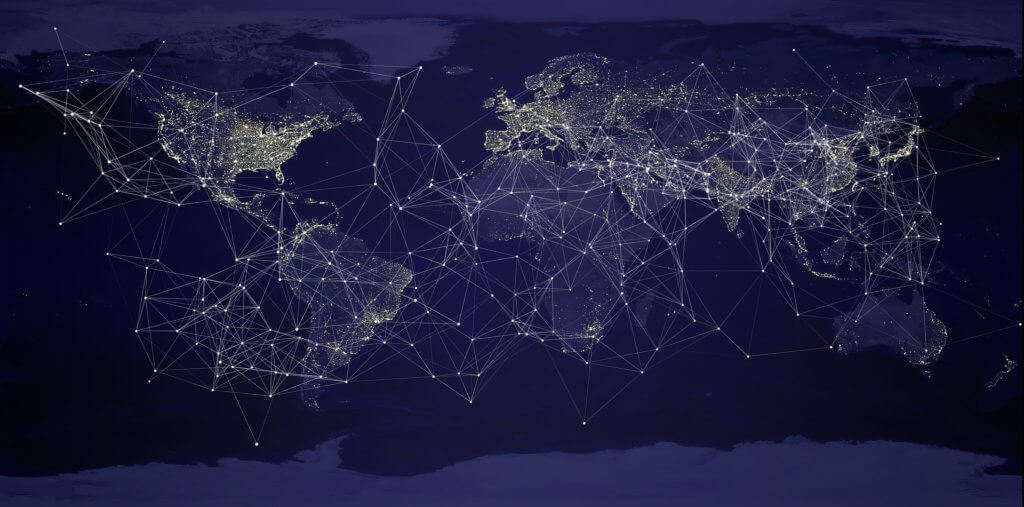
Before You Leave
Communication
Before you set off, you’ll need to think about how you’ll stay connected with your employer or clients and your friends and family while you’re abroad.
Because we usually travel within one country for 1-3 months at a time, we like to get a local SIM card when we arrive. They are affordable and you get both internet data and local calls and texts.
You’ll need to have an unlocked phone to put a new SIM card in. Most phones these days are unlocked, but you can make sure yours is at your current phone company.
We usually do research through Facebook Groups in the country we are traveling to find out which phone company is the most reliable. Then we go to that phone shop within the first few days of being in the country to get our SIM cards. In our experience, SIM cards cost between 8-20 USD per month.
*Note that you usually need to bring your passport when you go to buy a SIM card.
If you have a newer phone, you might be able to get en eSIM, which makes life A LOT easier. Instead of going to get a physical SIM card when you arrive in a country, you can install your eSIM directly in your phone and you’ll have data as soon as you arrive.
Jen’s phone has eSIM capabilities and she started using Airalo eSIMs in 2024. She’s used them in the UK, France, the US, Thailand, and India. The only place it didn’t work great was India, but she thinks she might not have installed it correctly, so the jury’s out on that one.
Get $3 off your first eSIM with Airalo with Jen’s code: JENNIF3484
Another company we have used (they gifted us an eSIM to try it out) is World eSIM. Their plans are more expensive than Airalo, but one benefit is that they offer regional plans, which means your eSIM will continue to work when you cross borders into different countries. We used a World eSIM for one month while traveling all over France and Spain in 2025 and it worked great everywhere.
Another option is Google-Fi which is significantly more expensive, but some digital nomads like having it for convenience.
Something to consider is whether you’ll keep your current phone number and phone plan that you use in your home country. It may be possible to ask your phone company to freeze your current phone number for a fee if you think you’ll want to have that number in the future.
Your Current Accommodation and Stuff
What are you going to do with your current residence when you leave? If you’ll be finishing a lease then you won’t be paying for accommodation in your home country while you’re away. Yay!
If you own your home, will you be renting it out while you’re gone? Do you have someone available to handle any issues that arise with your renters?
Something you’ll need to figure out is what you will use as your permanent address while you’re abroad. This is important to have when filling out documents when you are entering a new country, when applying for visas, etc. You may be able to use a family member’s address for this.
You’ll need to make sure that all of your mail is being forwarded to an address where it can be safely received.
Another thing to consider is what to do with all of your stuff? If you have things that you really can’t let go of by selling or donating them before you leave, then you need to decide where to store your things. If you have a relative or friend gracious enough to store a couple of boxes for you, that’s great. Otherwise, you may need to put some things into a storage unit. We advise you against this if possible because unless the things you’re holding onto are irreplaceable, it will likely be a waste of money to pay for a storage unit every month. You’ll probably forget what’s even in there!
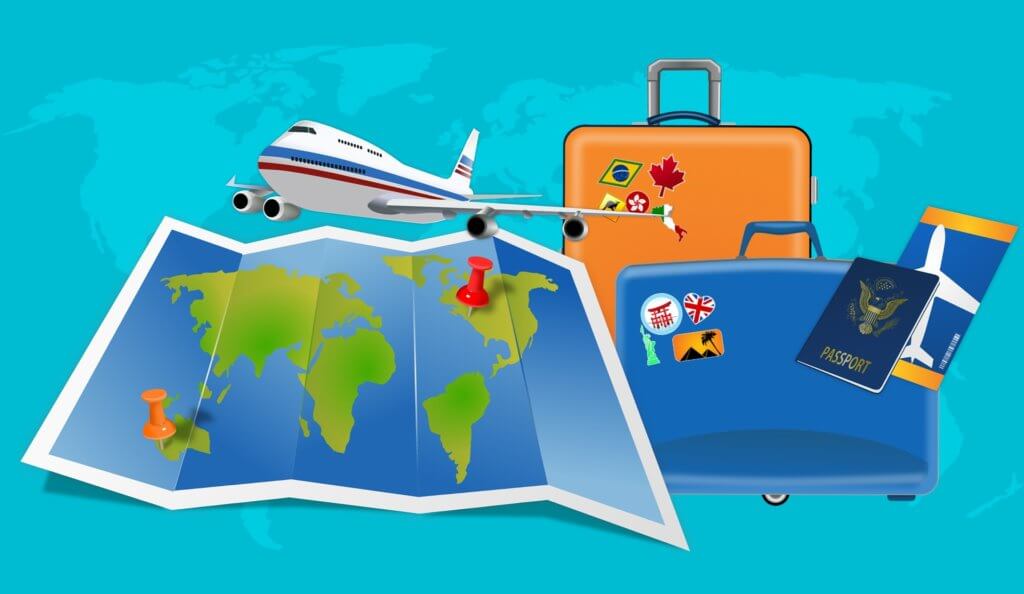
In Conclusion
There is A LOT to think about and do before you begin life as a digital nomad. The good news is, it’s all manageable and you can figure it out! We know that you can because we’ve done it too.
If you need additional help or guidance as you prepare to start long-term travel or the digital nomad lifestyle, send us a message on Instagram. We can answer all of your questions to help you through the process.
You can also check out our YouTube Channel where we make weekly videos about travel and digital nomad life to keep you motivated and inspired as you prepare for life on the road.
Download our free resources:
Digital Nomad Checklist
Accommodation Guide
Travel Housesitting Mini-Guide
Email any questions to Jen (at) twocantravel.com
Pin this article for later!
Are you thinking about traveling long-term or starting digital nomad life?
Let us know in the comments!
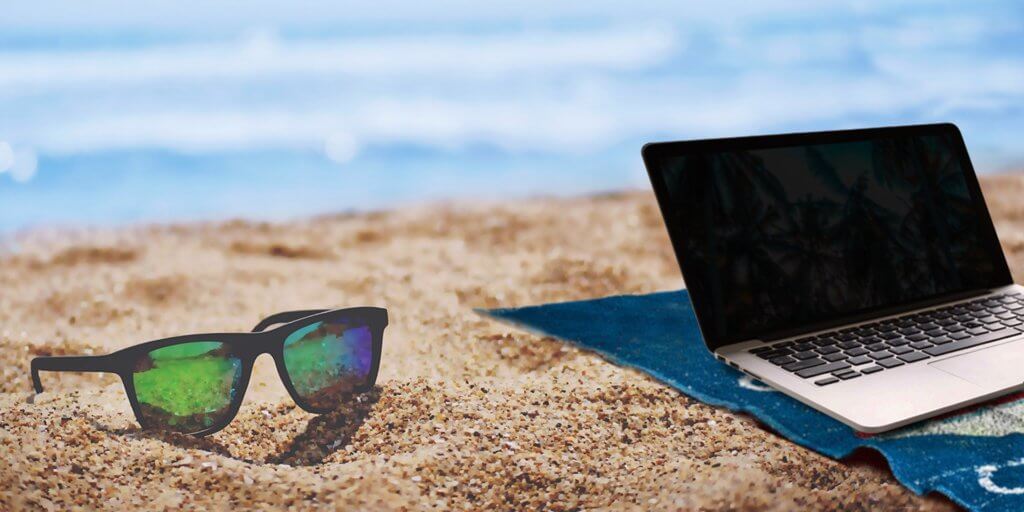
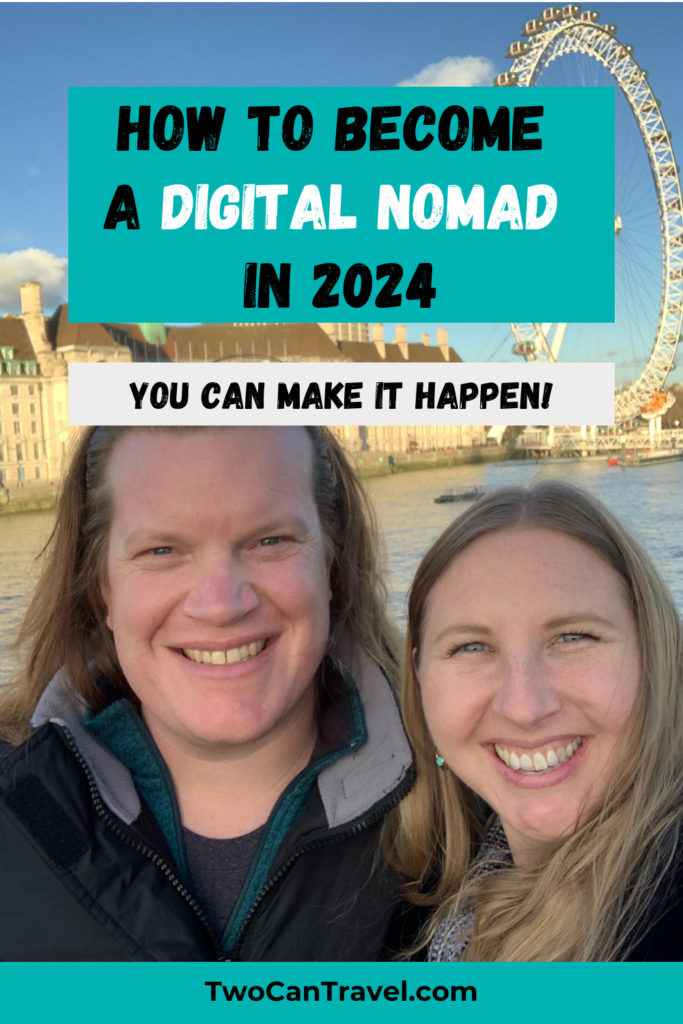
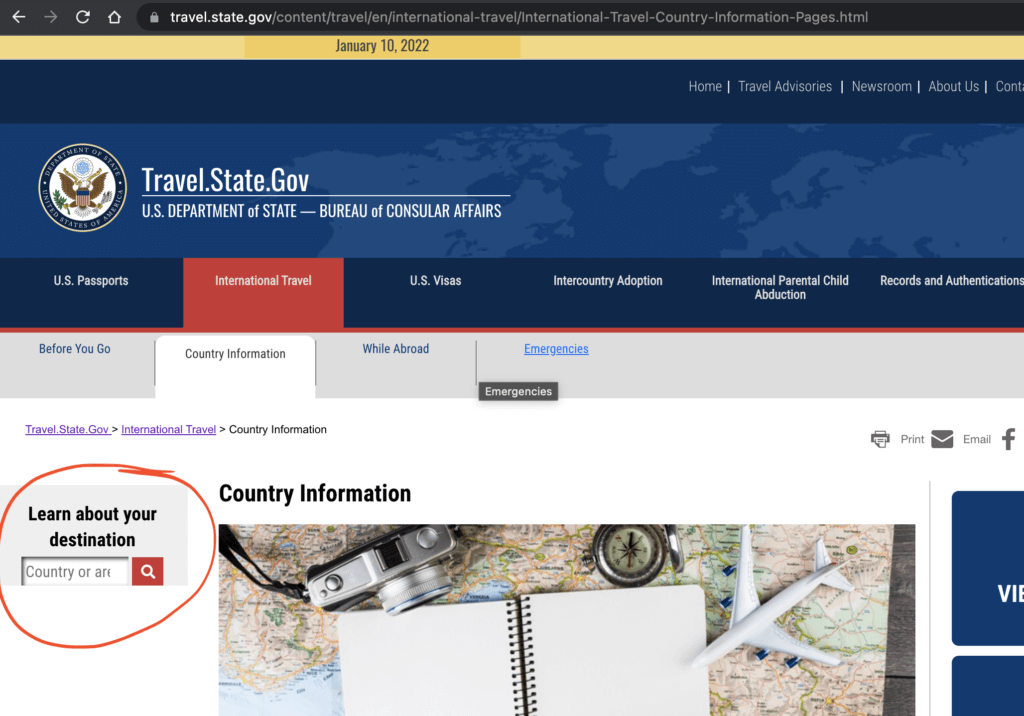
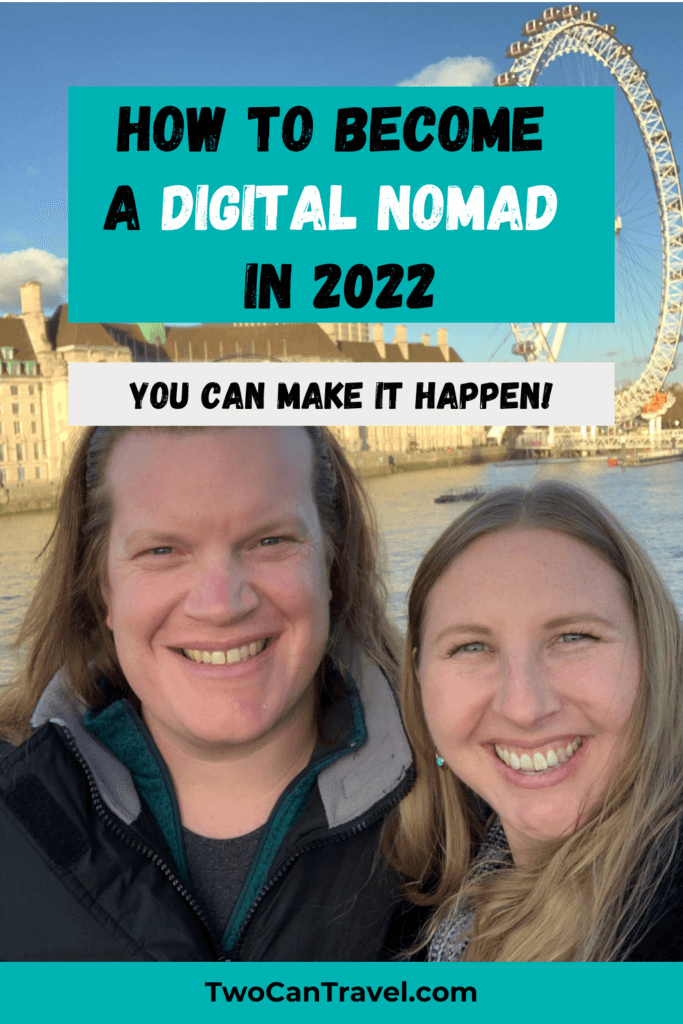
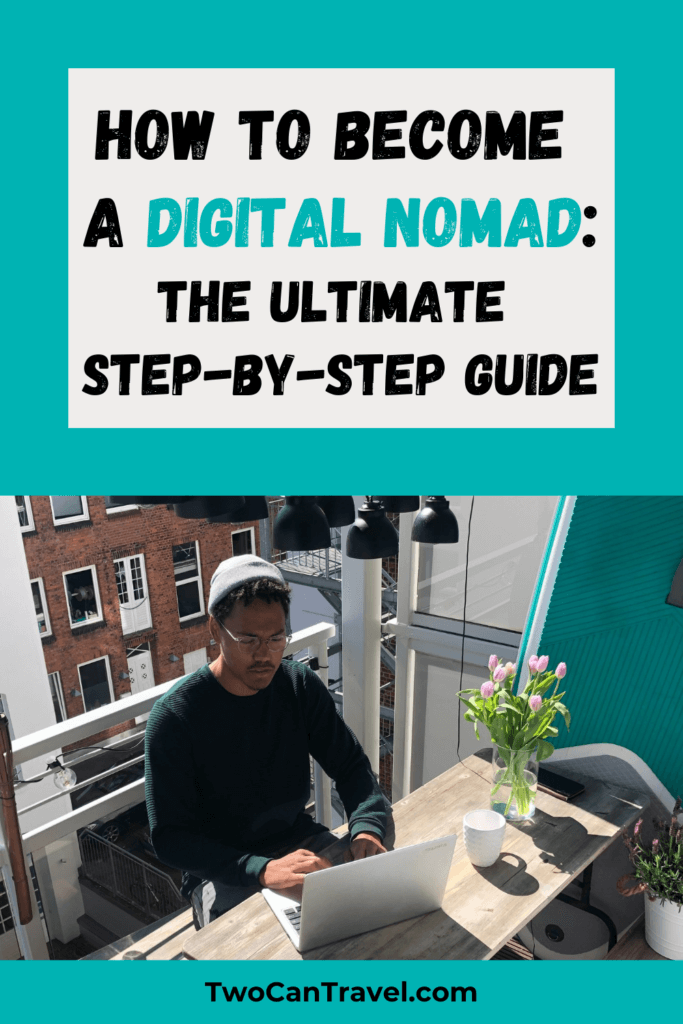
It’s a great list containing all the resources one would possibly need when flying off! I think most of us have a dream or desire to embark on a digital nomadic lifestyle, but it remains vague, and thus unrealized because we don’t know where to start, what to do next, what we might need. So, it’s really good to see something in black and white! This would be the post I would be coming to when making my own leap!
Thanks so much for your lovely comment! We’re happy to hear you find this article helpful as that was our goal 🙂 If you have any further questions about digital nomad life, don’t hesitate to ask them in the comments, or feel free to send us an email!